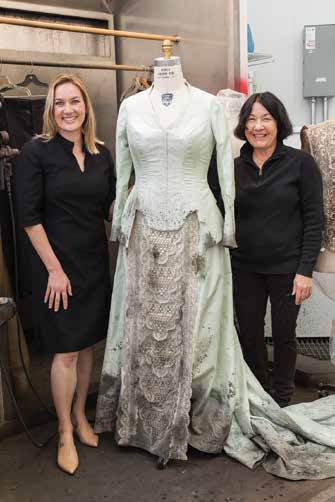
By Galen Till–
With the first onstage dress rehearsal of Dvořák’s fantasy opera Rusalka just days away, the costume studio at the San Francisco Opera is bustling. Given that the production tures over 100 individual costumes, each of the studio’s artisans plays an important role in bringing them to life. The production was originally designed for Lyric Opera of Chicago by Moritz Junge in 2014, so our job is to alter costumes to fit new singers, and if that’s not possible, to build new costumes from scratch.
In the main workroom, Senior Cutter Irene Murray is adding dyed bits of organza to the straps of Rusalka’s water nymph slip dress to add a light, almost ethereal quality. These pieces were added over the course of several costume fittings with Rachel Willis-Sørensen, who sings the title role.
Rusalka goes through the most dramatic changes as a character in the opera, and this is also true for her costumes. As such, she has two quick changes that we’ve needed to troubleshoot. The first is the moment that she leaves her watery home. Her dreamy floating slip dress is swapped for a simple linen dress. She has 5 minutes to change.
The second moment is in Act II. She changes from a beautiful red Victorian gown into her wedding gown and she has 3 minutes in which to do it. On our end, this takes so much troubleshooting as to what would work best. Does she have time to change boots? Does she have time to change bustles? It requires fine-tuned problem-solving skills and a knowledge of what is possible.
 At an adjacent table, Breanna Bayba, one of our Costume Technicians, is hand sewing faux fur trim onto the jacket for the Foreign Princess, sung by Sarah Cambidge. The dress that matches will get dazzling rhinestones heat set onto the bodice.
At an adjacent table, Breanna Bayba, one of our Costume Technicians, is hand sewing faux fur trim onto the jacket for the Foreign Princess, sung by Sarah Cambidge. The dress that matches will get dazzling rhinestones heat set onto the bodice.
Through the arch at the south end of the costume studio is the dye room, where Senior Dyer Amy Van Every is busy sponging the perfect amount of stage mud on the hem of the title character’s “distressed” wedding dress, worn in Act III. The stage mud consists of sawdust, paint and acrylic medium. This is the second of two identical dresses, alike in every way except for the mud and wear that Amy is applying.
One of the many interesting costumes in this production is that of the witch Jezibaba, sung by Jamie Barton. It was very important to the designer, Mr. Junge, that she didn’t look like a cartoon stereotype, but rather a real person. She wears layer upon layer of garments that one might imagine she’s found over the years. Each layer is dingy and falling apart, though there is the glimmer of something that may have been, once.

 Jezibaba’s familiars in our production are crows, played by dancers. Jersey, the Senior Crafts Artisan, has the unique challenge of working with each dancer to ensure that their crow mask is comfortable and easily seen out of, that their wings are in good shape, and that the dancers can use their fingers to climb ladders as the staging demands.
Jezibaba’s familiars in our production are crows, played by dancers. Jersey, the Senior Crafts Artisan, has the unique challenge of working with each dancer to ensure that their crow mask is comfortable and easily seen out of, that their wings are in good shape, and that the dancers can use their fingers to climb ladders as the staging demands.
Downstairs in the basement is our industrial spray booth, and it’s where Jersey carefully develops the perfect complexion for Vodník the Water Goblin’s webbed hands and feet using a spray gun filled with liquid latex and pigment. We’ve collaborated with the Wig & Makeup Department to ensure the skin tone on his prosthetics is a precise match with his makeup.
After the tireless efforts of 30 or so costumers, every costume piece will be meticulously checked out and moved to the War Memorial Opera House where we will have a week of onstage dress rehearsals. Notes will be taken, adjustments will be made, and by opening day on Sunday, June 16, a finished product will grace the stage and the costume studio will move on to the next show.
Galen Till is the Production Supervisor for “Rusalka” at San Francisco Opera, https://sfopera.com/
Recent Comments